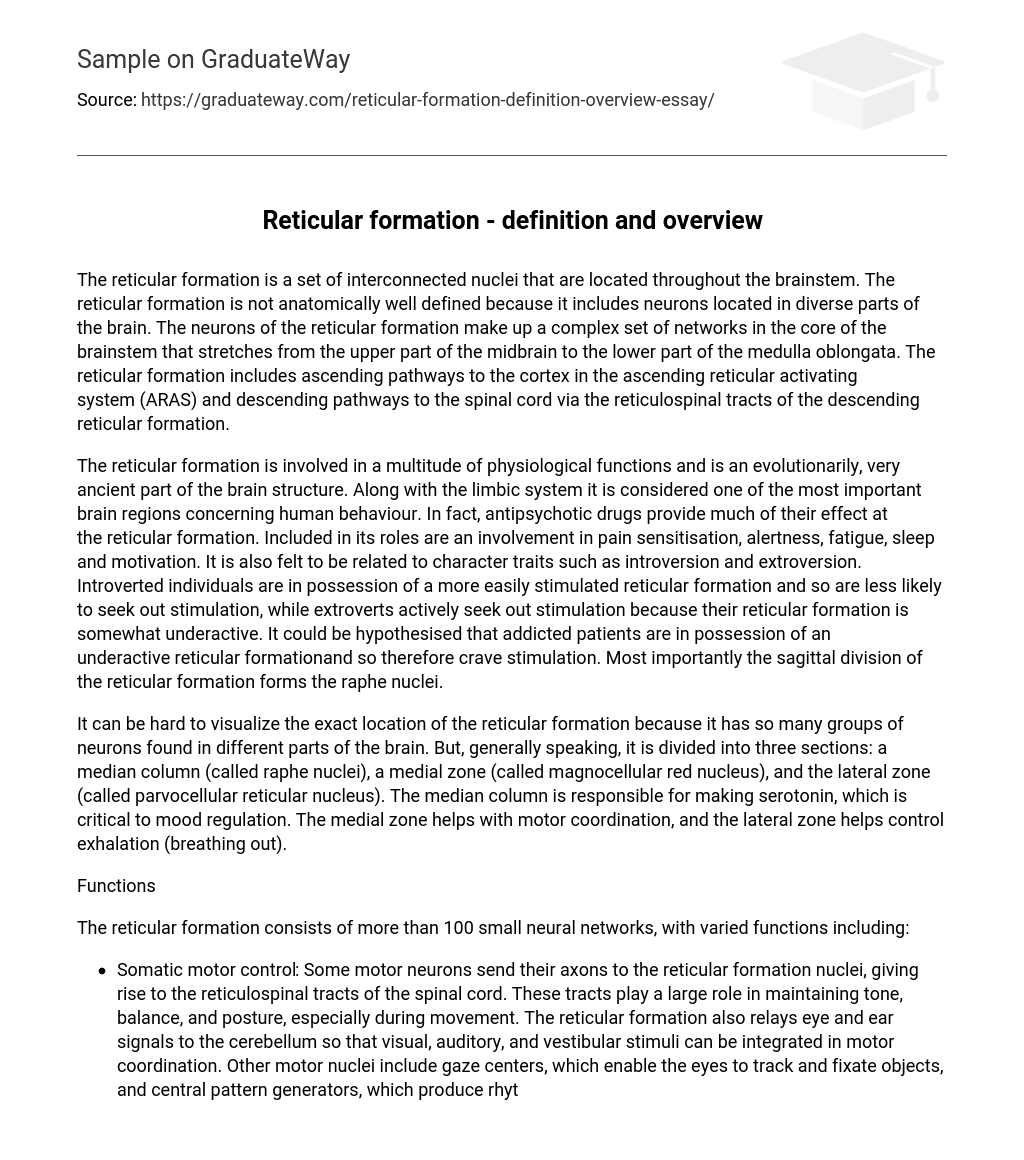The reticular formation is a set of interconnected nuclei that are located throughout the brainstem. The reticular formation is not anatomically well defined because it includes neurons located in diverse parts of the brain. The neurons of the reticular formation make up a complex set of networks in the core of the brainstem that stretches from the upper part of the midbrain to the lower part of the medulla oblongata. The reticular formation includes ascending pathways to the cortex in the ascending reticular activating system (ARAS) and descending pathways to the spinal cord via the reticulospinal tracts of the descending reticular formation.
The reticular formation is involved in a multitude of physiological functions and is an evolutionarily, very ancient part of the brain structure. Along with the limbic system it is considered one of the most important brain regions concerning human behaviour. In fact, antipsychotic drugs provide much of their effect at the reticular formation. Included in its roles are an involvement in pain sensitisation, alertness, fatigue, sleep and motivation. It is also felt to be related to character traits such as introversion and extroversion. Introverted individuals are in possession of a more easily stimulated reticular formation and so are less likely to seek out stimulation, while extroverts actively seek out stimulation because their reticular formation is somewhat underactive. It could be hypothesised that addicted patients are in possession of an underactive reticular formationand so therefore crave stimulation. Most importantly the sagittal division of the reticular formation forms the raphe nuclei.
It can be hard to visualize the exact location of the reticular formation because it has so many groups of neurons found in different parts of the brain. But, generally speaking, it is divided into three sections: a median column (called raphe nuclei), a medial zone (called magnocellular red nucleus), and the lateral zone (called parvocellular reticular nucleus). The median column is responsible for making serotonin, which is critical to mood regulation. The medial zone helps with motor coordination, and the lateral zone helps control exhalation (breathing out).
Functions
The reticular formation consists of more than 100 small neural networks, with varied functions including:
- Somatic motor control: Some motor neurons send their axons to the reticular formation nuclei, giving rise to the reticulospinal tracts of the spinal cord. These tracts play a large role in maintaining tone, balance, and posture, especially during movement. The reticular formation also relays eye and ear signals to the cerebellum so that visual, auditory, and vestibular stimuli can be integrated in motor coordination. Other motor nuclei include gaze centers, which enable the eyes to track and fixate objects, and central pattern generators, which produce rhythmic signals to the muscles of breathing and swallowing.
- Cardiovascular control: The reticular formation includes the cardiac and vasomotor centers of the medulla oblongata.
Pain modulation: The reticular formation is one means by which pain signals from the lower body reach the cerebral cortex. It is also the origin of the descending analgesic pathways. The nerve fibers in these pathways act in the spinal cord to block the transmission of some pain signals to the brain. - Sleep and consciousness: The reticular formation has projections to the thalamus and cerebral cortex that allow it to exert some control over which sensory signals reach the cerebrum and come to our conscious attention. It plays a central role in states of consciousness like alertness and sleep. Injury to the reticular formation can result in irreversible coma.
- Habituation: This is a process in which the brain learns to ignore repetitive, meaningless stimuli while remaining sensitive to others. A good example of this is when a person can sleep through loud traffic in a large city, but is awakened promptly by the sound of an alarm or crying baby. Reticular formation nuclei that modulate activity of the cerebral cortex are part of the reticular activating system.
References
- Courses.lumenlearning.com. (2017). The Brain Stem | Boundless Anatomy and Physiology. [online] Available at: https://courses.lumenlearning.com/boundless-ap/chapter/the-brain-stem/.
- En.wikipedia.org. (2017). Reticular formation. [online] Available at: https://en.wikipedia.org/wiki/Reticular_formation.
- Neuroscientifically Challenged. (2017). Know your brain: Reticular formation. [online] Available at: https://www.neuroscientificallychallenged.com/blog/know-your-brain-reticular-formation.
- Sciencedirect.com. (2017). Reticular formation – an overview | ScienceDirect Topics. [online] Available at: http://www.sciencedirect.com/topics/neuroscience/reticular-formation.





